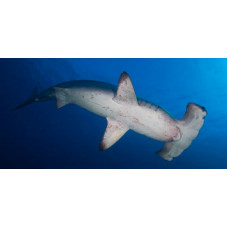Latin name
Sphyrna lewini
Other names
Zygaena lewini
Identification
The broad and flat head of the shark is divided into 2 lobes, with small eyes at the end of each lobe. The front edge of the "hammer" in adults is broadly curved, with notches in the middle and at the edges. Its width is 24-30% of the body length (usually more than 26%) and exceeds the distance from the tip of the snout to where the posterior edges of the "hammer" join the body. The length of the posterior edges of the "hammer" is greater than the width of the mouth. The distance from the tip of the snout to the mouth is 1/5-1/3 of the width of the head. The posterior margin of the eyes is just in front of the upper symphysis of the mouth. The mouth is broadly arched. The number of vertebrae is 174-209.
Teeth
Teeth with broad bases and slightly serrated edges. The incisors are rather long.
Features of fish fins
The first dorsal fin is sickle-shaped. Its base is posterior to the base of the pectoral fins. The free posterior tip does not reach the imaginary vertical line drawn through the beginning of the base of the pelvic fins. The second dorsal fin is small, smaller than the anal fin. Its base begins approximately above the midpoint of the base of the anal fin, which is 4.3-6.4% of the total length. The posterior edge of the anal fin is strongly concave. There is a notch on the edge of the upper caudal blade. The lower lobe is well developed but much smaller than the upper lobe.
Fish colouring
The coloration of the dorsal surface of the body is gray-brown. The belly is white. The tips of the pectoral fins have a dull dark edge.
Distribution
In the western Atlantic, they are found from New Jersey to Uruguay, including the Gulf of Mexico and the Caribbean. In the eastern Atlantic, its range includes the Mediterranean Sea and the waters around the Azores. It probably extends to the west coast of Africa (Mauritania, Senegal, Gambia, Ivory Coast, Guinea, Guinea-Bissau, Sierra Leone, Gabon and Congo). In the Indian Ocean, sharks are found off the coast of South Africa, Pakistan, India, Myanmar, the Maldives and the Red Sea. In the western Pacific they are found off Thailand, Vietnam, Indonesia, China, Taiwan, Japan, the Philippines, Australia (Queensland, Western Australia) and New Caledonia, while in the eastern Pacific their range extends from the southern coast of California to Panama, Ecuador and possibly northern Peru. They are also found in Tahiti and off Hawaii.
Habitat
This coastal pelagic species is found worldwide in temperate warm and tropical seas from 46°N to 36°S. They are found at depths of up to 1,000 meters, but mostly no deeper than 25 meters. They live on continental and island shelves and at the edge of deep water. They swim into coastal bays and estuaries.
Size
The Scalloped Hammerhead has a maximum recorded length of 4.3 meters and weighs 152.4 kg.
Behavior
They form large flocks and migrate to the pole in the summer. There is a permanent large population in the South China Sea. During certain periods of their lives, females and males may remain separate. In the waters of Baja California and the Gulf of California, mixed schools of these sharks have been observed, with different lengths and ages of both sexes, with females dominating. These packs congregated around islands and underwater pinnacles and exhibited behavior characteristic of both aggression and courtship. Many females and a small proportion of males bore bite marks, presumably from mating. The reason for the formation of such schools is not clear. It is unlikely to be related to reproduction, as there were immature individuals in the schools. Under these conditions, the fish were not threatened by potential predators. Sharks did not appear during strong currents and did not hunt during the daytime when observations were made.
Food and feeding habits
These sharks have a high metabolism, so they need a lot of food and get hungry quickly. Scalloped Hammerheads are opportunistic predators, feeding on whatever is available and abundant in their area. Juveniles typically feed on inshore fish, while adults feed on nearshore fish and larger organisms from deeper waters. The main diet consists of fish such as sardines, mackerel and herring, and occasionally cephalopods such as squid and octopus. Larger individuals may also feed on smaller shark species such as Carcharhinus melanopterus.
Reproduction
On average, males reach maturity at 1.5-1.8 m in length and weigh 29 kg, and females, which are generally larger, reach maturity at 2.5 m in length and weigh about 80 kg. They reproduce by live birth. Females give birth annually in spring or summer. Pregnancy lasts approximately 12 months. A litter contains 12-41 newborns ranging in length from 31-57 cm. Pups are often preyed upon by other sharks, including conspecifics.
Fishing
It is these sharks that are most often the victims of poaching for their fins.
Relationship with a person
These sharks are potentially dangerous to humans. However, observations of schools of these fish in the Gulf of California have documented their timid behavior toward divers.
| Classification | |
| Phylum | Chordata |
| Class | Chondrichthyes |
| Squad | Carcharhiniformes |
| Family | Sphyrnidae |
| Genus | Sphyrna |
| Species | S. lewini |
| Features | |
| Conservation status | Critically Endangered |
| Habitat | Pelagic |
| Life span, years | No information |
| Maximum body weight, kg | 152,4 |
| Maximum length, cm | 430 |
| Sailing speed, m/s | No information |
| Threat to people | Edible |
| Way of eating | Predator |
Scalloped hammerhead
Tags: scalloped hammerhead



